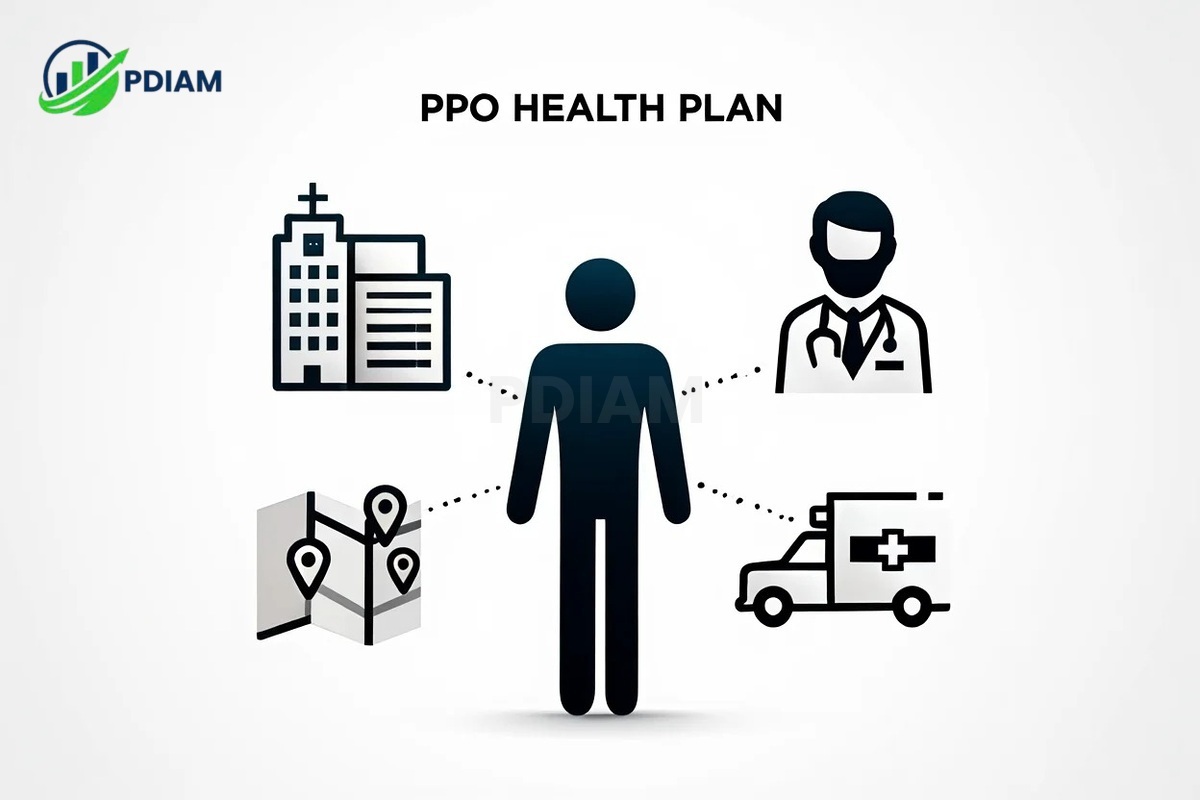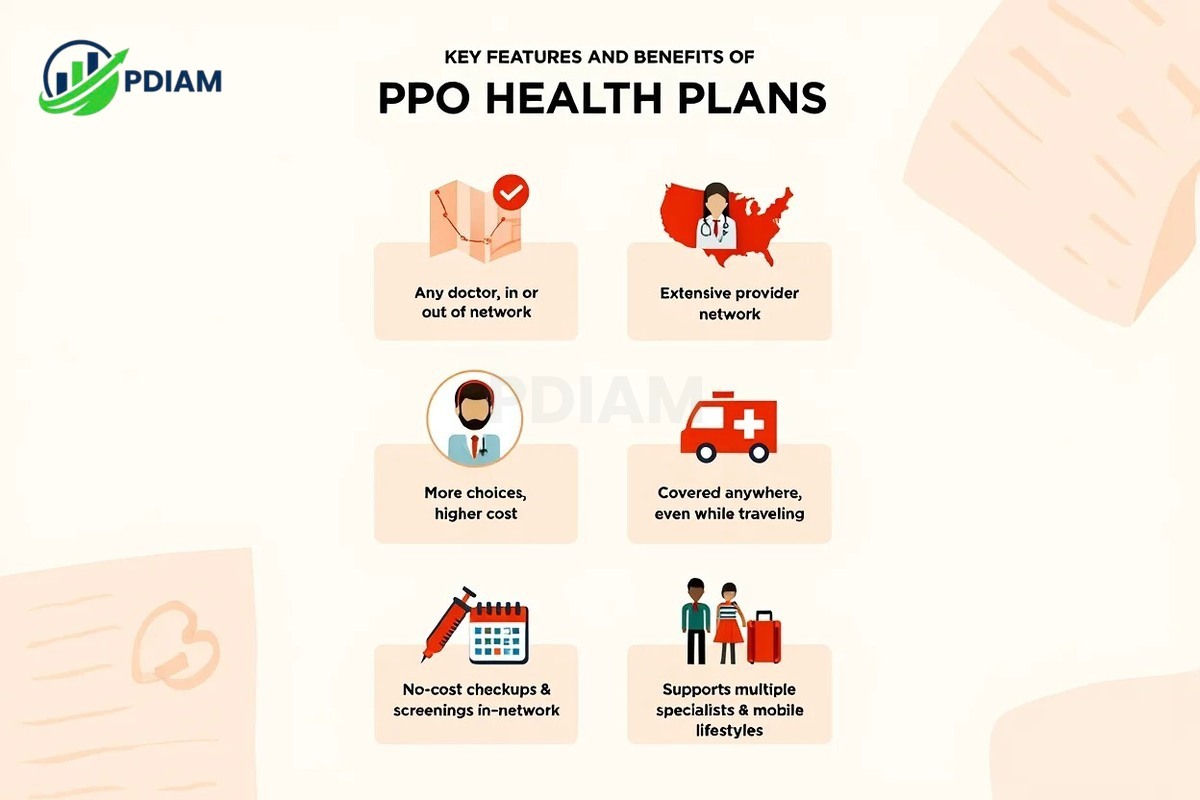If you’ve ever asked what is a PPO health plan, you’re not alone. In 2025, PPOs remain one of the most popular health insurance options in the United States, covering about 30% of insured Americans. They are known for flexibility, wide provider choice, and the ability to see specialists without referrals.
This guide explains exactly what a PPO health plan is, how it works, what makes it different from other insurance plans, and how to decide if it’s right for you. By the end, you’ll understand the structure, costs, pros, and cons,plus tips to get the most out of your coverage.
1. What is a PPO health plan?
A PPO (Preferred Provider Organization) is a type of health insurance plan that offers flexibility in choosing your doctors and hospitals. Unlike some plans, you don’t need a primary care doctor to direct your care, and you can see specialists without a referral.

Key features of PPO plans include:
-
Flexible choice of in-network and out-of-network providers.
-
No requirement for a primary care physician (PCP).
-
No need for referrals to see specialists.
-
Coverage for emergency care anywhere.
PPO plans offer convenience and choice, but understanding how they work is essential to making the right decision.
2. How does a PPO health plan work?
A PPO health plan organizes a network of doctors, hospitals, and providers who agree to offer services at discounted rates. Using in-network providers means lower costs, while going out-of-network costs more.
2.1. In-network vs. out-of-network
In-network providers have agreements with the insurer, offering lower rates. Out-of-network providers can charge more, and you may face balance billing,paying the difference between what they charge and what insurance covers.
2.2. Provider choice
PPOs let you see any doctor or specialist without a referral, giving you control over your care.
2.3. Preauthorization
While referrals aren’t needed, some services like surgeries or high-cost imaging may require preapproval.
Real Example: Maria injures her knee. She sees her in-network orthopedist without a referral, chooses an out-of-network physical therapist (paying more), and later visits an out-of-network ER, which her PPO covers for emergencies.
3. PPO health plan cost structure and coverage
Understanding the PPO health plan cost breakdown is key to avoiding unexpected expenses. The terms below explain exactly how much you’ll pay, when you’ll pay it, and how it impacts your total healthcare spending.
| Term | Definition |
|---|---|
| Premium | The fixed amount you pay each month to maintain coverage. |
| Deductible | The amount you must pay out-of-pocket before the plan starts sharing costs. |
| Copay | A set fee you pay for each doctor visit or prescription. |
| Coinsurance | The percentage of costs you pay after meeting your deductible. |
Sample PPO cost comparison:
| Service | In-Network Cost | Out-of-Network Cost |
|---|---|---|
| Primary Care Visit | $30 copay | 30% coinsurance after deductible |
| Specialist Visit | $50 copay | 40% coinsurance after deductible |
| Emergency Room | 20% coinsurance | 20% coinsurance |
Pro Tip: Always review the out-of-pocket maximum in your plan. This annual limit can protect you from excessive costs in a high-expense year.
Once you’re familiar with these cost components, you’ll be in a much better position to compare PPO plans and decide if the added flexibility is worth the price.
View more:
- How much does the average american make in their lifetime
- Which country markets are highest growing market in the world
- When was the new york stock exchange founded
4. Key features and benefits of PPO health plans
The popularity of PPO health plans comes down to their flexibility and broad coverage. Here are the standout features that make PPOs different from other plan types:

-
Freedom to choose doctors and hospitals: See any provider, in or out of network, without a referral.
-
Extensive provider network: Most PPOs offer nationwide access to doctors and specialists.
-
Out-of-network coverage: More options for care, though usually at a higher cost.
-
Emergency coverage anywhere: Ensures protection during urgent situations, even when traveling.
-
Preventive care at no cost in-network: Includes checkups, vaccinations, and screenings.
-
Family- and chronic-care friendly: Well-suited for people who require multiple specialists or frequent travel.
Pro Tip: If you or a family member frequently sees specialists or travels often, a PPO can provide unmatched convenience.
These features set the stage for a deeper comparison with other popular plan types, which we’ll explore next.
5. PPO vs. HMO, EPO, and POS
Knowing how a PPO compares to other plan types helps you choose what’s best for your needs and budget.
| Plan Type | Provider Choice | Referrals | Out-of-Network Coverage | Typical Premium |
|---|---|---|---|---|
| PPO | Broad, any provider | No | Yes, higher costs | High |
| HMO | In-network only | Yes | No (except emergencies) | Low |
| EPO | In-network only | No | No (except emergencies) | Medium |
| POS | In-network + referral | Yes | Yes, with referral | Medium |
Real Example: Frequent travelers often find PPOs worth the cost because they can get care in other states without being denied coverage,something HMOs can’t offer.
From this table, it’s clear PPOs strike a balance between choice, out-of-network benefits, and no-referral convenience.
6. Pros and cons of PPO health plans
When considering a PPO health plan, it’s important to weigh both the advantages and potential drawbacks.

Advantages:
-
Freedom to choose providers: You aren’t limited to a restricted list, which is especially helpful if your preferred doctor is out-of-network.
-
No referral needed for specialists: Saves time and makes it easier to get the care you need.
-
Out-of-network benefits: Greater access to more providers, especially in remote areas.
-
Nationwide emergency coverage: Peace of mind when traveling or on business trips.
-
Support for complex care needs: Ideal for those who require multiple specialists.
Disadvantages:
-
Higher premiums: Monthly costs are generally higher than HMO plans.
-
More expensive out-of-network care: Even with coverage, your share of costs can be significant.
-
Potential for balance billing: You may be billed for charges above the insurer’s payment.
-
Complex cost management: Multiple cost layers can make budgeting harder.
-
Prior authorization required for some services: May delay certain treatments.
Pro Tip: Choose a PPO if you value flexibility and access over lower monthly premiums.
7. Tips for choosing the best PPO plan
Selecting the right PPO health plan involves balancing your healthcare needs with your budget.
-
Evaluate your specialist needs: If you want to skip the referral process, a PPO may be the best fit.
-
Check your current doctors: Ensure they are in-network to reduce costs.
-
Estimate yearly expenses: Factor in premiums, deductibles, copays, and coinsurance.
-
Consider out-of-network coverage: Useful if you travel frequently or live near a state border.
-
Compare with other plan types: Look at HMO and EPO options to weigh cost vs. flexibility.
-
Seek real-world feedback: Read reviews or ask friends who use PPO plans.
Pro Tip: Use online comparison tools to filter plans by cost, coverage, and provider availability.
8. 30+ essential PPO health plan features and terms (checklist)
Before choosing or using a PPO, it’s important to understand the key terms in your plan documents. This checklist will help you navigate your benefits and avoid confusion.
-
Premium: The fixed amount you pay monthly to keep your PPO coverage active, regardless of whether you use services that month.
-
Deductible: The amount you must pay out of pocket each year before your insurance begins to share costs for covered services.
-
Copay: A set fee you pay for a specific service, like a doctor visit or prescription, often due at the time of service.
-
Coinsurance: The percentage of costs you share with your insurer after meeting your deductible,for example, 20% of the bill.
-
Out-of-pocket maximum: The highest amount you will pay in a year for covered services; once reached, the insurer pays 100% for the rest of the year.
-
In-network: Healthcare providers contracted with your PPO to offer services at discounted rates, leading to lower costs.
-
Out-of-network: Providers not contracted with your plan; using them usually costs more and may involve balance billing.
-
Balance billing: When an out-of-network provider bills you for the difference between their charge and what your PPO pays.
-
Referral: Formal permission to see a specialist; PPOs typically don’t require this, unlike HMOs or POS plans.
-
Preauthorization: Advance approval from your insurer required for certain services, such as major surgeries or high-cost imaging.
-
Preventive care: Routine health services like check-ups and screenings, often fully covered in-network to encourage early detection.
-
Primary Care Physician (PCP): Your main doctor for general care; PPOs don’t require you to designate one, but it can help coordinate services.
-
Emergency services: Care for urgent, life-threatening conditions, covered anywhere regardless of network status.
-
Formulary: The list of prescription drugs your PPO covers, often divided into cost tiers.
-
Claims: Requests sent to your insurer for payment after receiving healthcare services.
-
Explanation of Benefits (EOB): A statement from your insurer detailing what was paid, what you owe, and why.
-
Flexible Spending Account (FSA) / Health Savings Account (HSA): Tax-advantaged accounts to pay for eligible medical expenses; HSAs require a high-deductible plan.
-
Urgent care: Clinics offering same-day treatment for non-emergency issues like minor injuries or infections.
-
Telemedicine: Virtual healthcare visits by phone or video, often at a lower cost and more convenient than in-person visits.
-
Exclusions: Specific services or treatments your PPO doesn’t cover, listed in the plan’s documentation.
-
Covered services: All the healthcare benefits included in your plan’s coverage.
-
Enrollment period: The designated time frame when you can sign up for or change your PPO plan, such as during open enrollment.
-
Specialist: A doctor focused on a specific area of medicine, like cardiology or dermatology, that you can see without a referral in a PPO.
-
Network tiering: Some PPOs divide providers into tiers with different cost levels depending on the tier you choose.
-
Prior authorization turnaround time: How quickly your insurer processes requests for preapproval of certain services.
-
Preventive vs. diagnostic services: Understanding the difference helps you avoid unexpected bills if a screening becomes diagnostic.
-
Lifetime maximum: The total amount your PPO will ever pay for covered services, though many plans have removed this cap.
-
Premium subsidy: Financial assistance that lowers your monthly premium if you qualify based on income.
-
Grace period: The time you have to pay your premium after the due date before coverage is canceled.
-
Cost-sharing reduction (CSR): Discounts on out-of-pocket costs for eligible enrollees, often through marketplace plans.
-
Medical necessity: The standard insurers use to decide if a service is covered.
-
Coordination of benefits (COB): How your PPO works with another insurance plan if you have dual coverage.
By understanding these terms, you can make better decisions about when, where, and how to get care,helping you maximize your PPO benefits and avoid surprise costs.
Check out our:
- Do you get a severance package if you get fired? Know your rights [2025]
- Which statements about the accrual-based method of accounting are true? Must-Know in 2025
- How much does Health insurance cost per month? Avoid overpaying [2025]
9. Frequently asked questions about PPO health plans
9.1. Can I keep my current doctor with a PPO?
Usually yes, if they are in-network. Out-of-network is allowed but costs more.
9.2. Do I need a referral to see a specialist?
No, PPOs allow direct access.
9.3. Is emergency care covered out-of-network?
Yes, emergency visits are generally covered regardless of provider.
9.4. Are preventive services free?
Yes, in-network preventive care is usually fully covered.
9.5. Do PPOs have deductibles?
Yes, most require meeting a deductible before coinsurance applies.
9.6. Can I use a PPO if I travel often?
Yes, PPOs are ideal for travelers and multi-state residents.
10. Conclusion
Now you know what is a PPO health plan, how it works, and whether it’s right for you. PPOs provide unmatched flexibility, wide provider choice, and no referral requirements, making them ideal for frequent travelers, families, and those needing specialized care.
Key takeaways:
-
PPOs offer both in- and out-of-network coverage.
-
Expect higher premiums for more freedom.
-
Understand costs like premiums, deductibles, and coinsurance.
-
Compare with HMO, EPO, and POS before choosing.
With this knowledge, you can confidently evaluate your options and select a plan that aligns with your health needs and budget.
Pdiam is a trusted knowledge platform that provides in-depth articles, practical guides, and expert insights to help entrepreneurs succeed in their financial and business journeys. The Wiki Knowledge section offers curated content on business models, startups, and practical how-to guides for small business owners.













